5.30pm Read all about it!
You can now read our story of the discovery of the Crispr–Cas9 gene editing system and how it is set to transform both medicine and food production. We’ve also produced an explainer laying out the science of Crispr and gene editing – a worthy winner of the 2020 chemistry Nobel prize. Next week we’ll have a long read on the awarding of the Nobel prize for gene editing so be sure to return for that.
Otherwise, that’s all from the live blog today and thank you for joining us. It’s been a great day for chemistry and science.
4.36pm Charpentier interview
“This has been an incredible explosion of knowledge and publications”
Emmanuelle Charpentier, chemistry Nobel laureate 2020
4.04pm Definitely happy!
Jennifer Doudna, chemistry Nobel laureate 2020
Congratulations to our newest #NobelPrize laureate Jennifer Doudna.
— The Nobel Prize (@NobelPrize) October 7, 2020
From this picture we can imagine that she was happy to find out she had been awarded this year’s Chemistry Prize! pic.twitter.com/rK7FILsW15
3.42pm That was fortunate
And by happy chance World Crispr Day 2020 is coming up on the 20th October! Jennifer Doudna will be giving the keynote speech at the virtual event, which is open for registration now.
3.35pm I think she looks quietly pleased!
3.25pm A message from Charpentier
“My wish is that this will provide a positive message to the young girls who would like to follow the path of science, and to show them that women in science can also have an impact through the research that they are performing.”
— The Nobel Prize (@NobelPrize) October 7, 2020
- 2020 Chemistry Laureate Emmanuelle Charpentier. pic.twitter.com/0yWdih3hpl
3.05pm Timing is everything
Jennifer Doudna’s picked a hell of a week to launch her latest gene editing venture. Yesterday, Scribe Therapeutics, the spin-out she co-founded, announced a $20 million collaboration with Biogen to start work on treatments for amyotrophic lateral sclerosis or ALS using Crispr. This disease is hereditary making it difficult to treat and is why there is such excitement about a gene editing system that could potentially replace faulty genes with healthy ones. Previous Nobel prize winners have said things don’t calm down for months so it’s quite likely some of the co-founders of Scribe will be taking on some of the day-to-day duties.
2.51pm Lasker Prizes
As has been noted today, other prestigious prizes often foreshadow the Nobel prizes. The Lasker Prizes are often seen as one of the best predictors of future success, particularly for the medicine prize and for the chemistry prize if it has a biochemistry/medicine bent to it. The prize has rewarded future Nobel medicine laurates such as James Allison, Greg Semenza and John Gurdon, and even a few chemistry winners such as Jack Szostak. But interestingly, neither Charpentier or Doudna have ever won a Lasker Prize, something that seems particularly surprising given its potential applications in medicine. Perhaps the awards panel considered it too soon for the clinical prize as Crispr hasn’t yet translated into new medicines and the fight over priority may have put them off awarding the basic prize to Crispr.
2.01pm “Suddenly it was there. They found something amazing!”
Professor Claes Gustafsson, Chairman of the Nobel Committee, explaining what Crispr is, why it won the Nobel and why it’s such an exciting field of research worthy of the prize.
1.51pm Ouch!
Sluggish peer review may have played a part in Virginijus Siksnys being overlooked as one of the key discoverers of Crispr. One thing that often amazes me about science is how key discoveries are often made so close to each other. A recent Angewandte Chemie essay looked at this in detail. The paper suggests that twinning – where a discovery is made independently at the same time – has become a more frequent phenomenon. While in the 20th century the phenomenon of twinning was more likely to be serendipitous, they contend that it’s now the norm in the 21st century as a result of scientists looking more and more to popular themes and funding agency back thematic areas.
Virginijus Šikšnys has everyone beat as far as most gutting desk rejection of all time. pic.twitter.com/8rAXIDbRKa
— ChemBark (@ChemBark) October 7, 2020
1.37pm Crispr is everywhere
The technology that started off as a niche discovery of a bacterial immune system has ballooned and is now used by research groups all around the world. The ability of the technique to neatly snip out portions of DNA and, if so desired, replace them with new sequences means that it’s now being commercialised for use in food, organ transplants and, unsurprisingly, medicine. It’s greatest potential may indeed lie in treating genetic illnesses such as cystic fibrosis, where a faulty gene could be excised and then replaced with a healthy one. We’ve gathered together some of our relevant stories for you and will shortly be publishing a news story and explainer on the technique.
1.17pm Prizes galore
Previous awards – particularly the most prestigious ones – are often good predictors of future Nobel success. The Wolf Prize is often a good marker for Nobel success and Charpentier won the Wolf Prize in Medicine earlier this year (make of that what you will!) – there was no Wolf Prize in Chemistry awarded this year. Charpentier also won the Breakthrough Prize in Life Sciences with Jennifer Doudna in 2015 which comes with over £2 million in prize money. Other significant prizes she has won include the Japan Prize in 2017 and the Kavli Prize in Nanoscience in 2018.
As mentioned above Doudna shared the Breakthrough Prize in Life Sciences with Charpentier. In fact this pair have been a bit of an awards double act. They also won the Japan Prize the same year (2017), the Wolf Prize in Medicine (2020) and the Kavli Prize in Nanoscience (2018). No surprise that they won the chemistry Nobel prize as a pair too then. Virginijus Siksnys shared the 2018 Kavli Prize in Nanoscience with Charpentier and Doudna.
12.32pm More comment coming in
Dr Christophe Galichet, Senior Laboratory Research Scientist, The Francis Crick Institute, said:
“The use of CRISPR has revolutionised science. Jennifer Doudna and Emmanuelle Charpentier were pioneers in understanding the role of the CRISPR system. Their works have been instrumental for the use of CRISPR in all aspects of life science.
“CRISPR/Cas system allows to generate genomic alteration at a desired location. What is incredible with the system is the specificity of targeting the genome (it could be compared to an excellent GPS) and its ability to generate genomic alteration at a rate never seen before.
“Now CRISPR is used for generating genomic alteration in any cells and in any organisms.
“It is a fantastic news to hear that two brilliant women have been awarded the prestigious Nobel prize.”
Fiona Watt, MRC Executive Chair, said:
“Many congratulations to Emmanuelle Charpentier and Jennifer Doudna. Their work is a great example of how discovery science underpins major improvements in human health. CRISPR/Cas genes are part of the bacterial immune system, yet they are now being applied to correct genes in a number of devastating human diseases such as muscular dystrophy.”
Prof Sir Mark Caulfield, Chief Scientist at Genomics England, said:
“I am particularly delighted that this year’s Nobel Prize in Chemistry recognises two women pioneers of gene editing, which is already yielding amazing new biological insights and may pave the way for potential therapies.”
Prof Douglas Kell, Professor of Bioanalytical Science, University of Manchester, said:
“Completely well deserved. It is an utterly transformative technology. Most of the focus will be on medicine, but using CRISPR/Cas-type technologies to produce productive and safe microbes for industrial biotechnology and the sustainable BioEconomy is in many ways likely to be even bigger.”
Dr. Angela Zhou, an Information Scientists at CAS, a division of the American Chemical Society specializing in scientific information.
“I am not surprised to see CRISPR recognized with the Nobel this year. CRISPR is a technology that has had a rapid and significant impact because it can quickly, economically, and accurately change the specific DNA sequence in a genome. It is already contributing to progress in diagnosing human diseases, developing new treatments, and even in agriculture. Personally, it is also great to see the prize awarded to two women who are earlier in their career as I believe it will provide tremendous encouragement to younger women pursuing research careers across scientific disciplines.”
12.18pm And biochemistry extends its lead
And if we look at the subfields of chemistry that are winning the prizes there’s only one story in recent years.
12.03pm Reactions from the great and the good
Prof Tom Welton, President of the Royal Society of Chemistry said:
“Congratulations to Emmanuelle Charpentier and Jennifer Doudna, whose Nobel recognition is hugely deserved, not least considering how transformative their CRISPR discoveries are already proving.
“The ability to edit genes provides an incredible toolkit for scientific research that will benefit humankind for generations to come, from fighting and preventing diseases to feeding our growing global population.
“I am also hugely pleased to see that the Nobel committee has chosen to honour two leading women in active research – their teamwork is an example of how scientific breakthroughs are based on a truly global community of researchers and they can become role models for aspiring scientists of all genders.”
Prof Ali Tavassoli, Professor of Chemical Biology Chemistry, University of Southampton, said:
“It is good to see the Nobel committee recognise the significance and importance of this relatively recent discovery; there is tremendous potential for CRISPR to alter our approach to treating genetic disorders and disease.
“The technique has been widely adopted and used by a large number of laboratories around the world and has made important indirect contributions to multiple scientific advances. It should also be noted that this work arose from ‘blue skies’ research, highlighting the importance of scientific research that may not immediately have an application”.
Dr John Parrington, Lecturer in Cellular & Molecular Pharmacology, University of Oxford, said:
“I think this is very well deserved indeed. CRISPR/Cas genome editing is a revolutionary technology that has made it possible for the first time in history to precisely edit the genomes of living cells of practically any species. It is already having a major impact on biomedical research, clinical medicine, and agriculture and indeed society as a whole. It has immense potential to transform our lives for the better but also raises many ethical and socio-political questions.
“In fact a number of other scientists have made important contributions to this discovery, but there is no doubt that Jennifer Doudna and Emmanuelle Charpentier played a key role in understanding the mechanism of CRISPR/Cas in bacteria and how it might be developed as a genome editing tool.
“I particularly welcome the award of this prize to two outstanding women scientists and I hope this serves as a stimulus for more women to be inspired to seek careers in the field of science and technology.”
11.46am Crispr is all very nice, but is it biology?
That question we alluded to below in the run-up to the prize is rearing it’s head once more. There’s a great chat going on there on Twitter right now if you want to read (or jump in) with many top writers and scientists giving their tuppence worth.
9.34am A biology prize?
Every year, sure as night follows day, you can expect predictions that the chemistry Nobel prize will go to ‘biologists’. It’s become a running joke among the chemistry community. Some shrug it off saying it’s all chemistry or point to the interdisciplinary nature of the central science, while others have sat down and crunched the data. That’s what Jeffrey Seeman of the University of Richmond in the US and Guillermo Restrepo of the Max Planck Institute for Mathematics in the Sciences in Leipzig, Germany, did at the end of last year. Their conclusion – it’s true, the identity of the chemistry prize has changed over the years and it would be better described as the ‘Nobel Prize in Chemistry or Life Sciences’.
I was at a dinner with Emmanuelle Charpentier in Montreal last year. I cheekily asked her if CRISPR wins a @NobelPrize, did she think it would be #MedNobel or #ChemNobel... she said #MedNobel - still, I bet she'll be happy today!
— Stuart Cantrill (@stuartcantrill) October 7, 2020
Its a #chemtwitter #ChemNobel tradition to grumble.
— Prof Mark Lorch (@Mark_Lorch) October 7, 2020
And then someone points out that it is Biochemistry. And since Biochem is the study of the chemical processes relating to living organisms it still counts as chemistry.
11.42am The winners
And here are Emmanuelle Charpentier, Max Planck Unit for the Science of Pathogens, Berlin, Germany, and Jennifer A. Doudna, University of California, Berkeley, US, who have jointly won the 2020 chemistry Nobel prize “for the development of a method for genome editing”. The photo was taken at the 2015 Princess of Asturias Award for Technical and Scientific Reseach from Spain’s King Felipe during the Princess of Asturias awards ceremony at the Campoamor Theatre in Oviedo, on 23 October 2015.
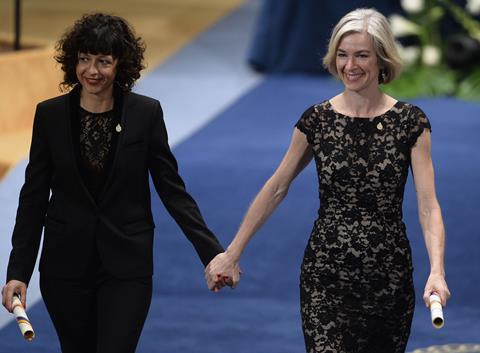
11.29am Breaking the news
Obviously the Royal Swedish Academy of Sciences couldn’t get hold of Jennifer Doudna!
"Doudna was “really sound asleep” when her buzzing phone woke her and she took a call from a Nature reporter, who broke the news." what a moment @heidiledford https://t.co/DRH7erimJx
— Richard Van Noorden (@Richvn) October 7, 2020
11.21am Going live
Our business editor, Phillip Broadwith (@broadwithp), is chatting live now on Al Jazeera English news channel discussing this year’s prize shortly after it’s announced so tune in! We think it’ll be around 11am.
An exciting addition to our coverage of the #ChemNobel this year is an interview with our very own @broadwithp on @AJENews a little later on to discuss the winners and the work behind it all - check out the livestream here: https://t.co/TOXolVPA3K
— Chemistry World (@ChemistryWorld) October 7, 2020
11.16am Women in Stem
This is a first for the chemistry prize – or any Nobel prize we believe. Two women have never been the sole nominees on a prize. Let’s take a look at the ratio of men to women in the Nobels now.
11.14am Another who missed out
Lithuaninan Virginijus Siksnys also had a good shout to have been on the Nobel prize citation. He was awarded the Kavli prize along with Charpentier and Doudna for work on Crispr. His work has been described as overlooked in the past.
11.12am Reactions
We’ll be posting reactions and our news story and explainer throughout the day so stick with us.
11.03am Crispr – got you covered
A great deal has been said about Crispr and Chemistry World has covered the topic in depth over the years. Our feature length article on the topic is a good place to start. You might also be interested in our review of newly-minted chemistry laureate Jennifer Doudna’s book and the review of a documentary on Crispr. There has also been a lot said about He Jiankui’s use of Crispr to edit the genomes of a number of human embryos that were then brought to term. There has been concern that these gene edited children may be at greater risk of genetic illnesses later in life as the gene editing performed on the embryos has been criticised as sloppy. Jiankui has now been sentenced to three years in jail by Chinese authorities.
10.56am Missing out
As always, there are people who could have been included in the prize but weren’t. The Nobel prizes can only be awarded to three people maximum and others such as Feng Zhang or George Church could have been included. But that’s the way of the Nobel prizes and many, many words have been written about the nature of science today – that it favours large interdisciplinary teams and that it’s a group effort.
10.51am Many congratulations!
Well done to Emmanuelle Charpentier and Jennifer A. Doudna who ’discovered one of gene technology’s sharpest tools: the CRISPR/Cas9 genetic scissors. Using these, researchers can change the DNA of animals, plants and microorganisms with extremely high precision. This technology has had a revolutionary impact on the life sciences, is contributing to new cancer therapies and may make the dream of curing inherited diseases come true.’
Many had doubted that Crispr would be awarded – yet. It’s impact on the field of genetic engineering cannot be overstated. It’s led to precision engineering of organisms – and even (illegally) humans – but the discoverers are engaged in a legal fight over who owns the rights to the technology. Nobel watchers had assumed there prize wouldn’t be awarded until this legal dispute was resolved.
10.49am So soon for Crispr
BREAKING NEWS:
— The Nobel Prize (@NobelPrize) October 7, 2020
The 2020 #NobelPrize in Chemistry has been awarded to Emmanuelle Charpentier and Jennifer A. Doudna “for the development of a method for genome editing.” pic.twitter.com/CrsnEuSwGD
10.48am It’s Crispr!
Bit of a surprise there
10.46am Here we go…
Looks like they’re getting ready to go.
10.43am No movement yet…
The physics prize was delayed by 15 minutes or so yesterday.
10.40am Get ready…
Just five minutes to go.
10.38am Past performance…
The Lasker Awards – highly prestigious prizes in the biosciences – have often been good predictors of both the medicine and physiology and chemistry Nobel prizes over the years. However, as a result of the pandemic the awards were cancelled this year.
As we’ve established, the chemistry Nobel prize now reward discoveries in biochemistry more than any other field. Last year the basic research prize was given for the discovery of two classes of lymphocytes – B and T cells – to Max Cooper and Jacques Miller, which ‘launched the course of modern immunology’. The clinical research award went to H Michael Shepard, Dennis Slamon and Axel Ullrich for the development of Herceptin, the first monoclonal antibody that targets cancer. The award for Shepard, Slamon and Ullrich might have been a good bet for the medicine and physiology Nobel prize – if George Smith and Gregory Winter hadn’t taken half of the chemistry prize in 2018 for work that led to the development of monoclonal antibody drugs.
To prove the point that the Lasker Awards can be a good predictor of medicine and physiology or chemistry prize success, you need look no farther than 2019 medicine Nobel prize. In 2016, William Kaelin, Jr, Peter Ratcliffe and Gregg Semenza won the Albert Lasker Basic Medical Research Award for their work on how animals’ cells can sense and adapt to changes in oxygen. In 2019, William Kaelin, Jr, Peter Ratcliffe and Gregg Semenza won the physiology or medicine Nobel prize for their work on how animals’ cells can sense and adapt to changes in oxygen. Let’s see what happens this year…
10.34am The results are in
Our Twitter followers have spoken and it looks like the favourite to win this year, taking 30.5% of the 410 votes, is gene editing tool Crispr! It was a relatively close run between gene editing and the somewhat-ambiguous ‘anything else’ category, but both were well ahead of DNA synthesis (in last place with 18.5% of the vote) and MOFs (20.7%)
Today's the day! 🥳 The chemistry #NobelPrize2020 is all set to be announced at around 10:45 BST, but what do you think is going to win this year? Let us know!
— Chemistry World (@ChemistryWorld) October 7, 2020
10.31am Nearly there
Just 15 minutes until the announcement now. You can watch it live here.
10.29am Nominal inflation
Nominations have been steadily rising over the years, possibly due to research communities becoming larger and maybe due to the Nobel become more well-known over the years. The fewest nominations (11) were received in 1918 and the most in (153) in 1966. I imagine those figures would be dwarfed by nominations today.
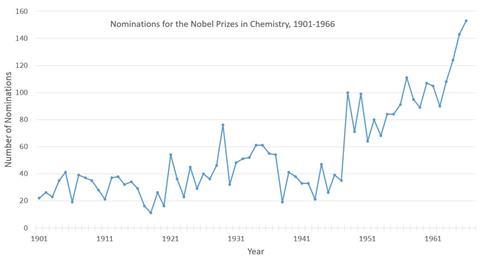
10.26am More nominations nuggets
• Most prolific nominator: 1929 Nobel laureate Hans von Euler-Chelpin, who named 59 people across 35 nominations from 1907 to 1960. He was very keen for a Nobel to go to Walter Reppe, whom he nominated every year for a decade starting from 1950. Reppe’s in-depth research on acetylene chemistry did bring him lasting chemistry fame – he was one of the early supporters of organometallic catalysis for industry – but never won a Nobel prize.
• Most indecisive nominator goes to German organic chemist Karl Johann Freudenberg who in 1965 nominated a total of seven individuals, three of whom later received a prize: Fritz Arndt, Hans Lebrecht Meerwein, Robert Burns Woodward, Georg Wittig, Alfred Rieche, Rudolf Criegee, Manfred Eigen. Usually, people only name one or two individuals in a single nomination.
10.23am Nobel chat
Our business editor, Phillip Broadwith (@broadwithp), will be chatting live on Al Jazeera English news channel discussing this year’s prize shortly after it’s announced so tune in! We think it’ll be around 11am.
10.20am Some words from the chemistry Twitterati
A lot of love for Carolyn Bertozzi and bioorthogonal chemistry on Twitter right now #chemnobel.
I've made no secret who I'm vying for in the #ChemNobel - Sharpless and Bertozzi. But click chemistry always reminds me of Richard Nixon's campaign song (and this is real):
— Dr. Kit Chapman (@ChemistryKit) October 7, 2020
"Come on and / Click with Dick/ The one that none can lick..."
The upside of having an 8 month old is that I am at least up at a convenient time to see the #ChemNobel announcement anyway
— Marshall Brennan (@Organometallica) October 7, 2020
Orthogonal chemistry - researchers found a way to use our cells as tiny flasks, and perform chemical reactions within. (OK maybe not the same but that's been my bet since 2016 and it's about time they recognise this)
— 🧪 Fernando (@gomobel) October 6, 2020
Rooting for @CarolynBertozzi for tomorrow’s #ChemNobel 🤗🤗
— Dr Carmen Monoxide (@CARM1Monoxide) October 6, 2020
It's #ChemNobel day!!! I hope my students won't mind 15 minutes of awkward silence during the lecture, while I am watching the live feed... pic.twitter.com/Nd5RwnkrLI
— narf42 (@narf42) October 7, 2020
Thinking @CarolynBertozzi should be among the #ChemNobel winners.
— aliyu akeem (@aliyuakeem) October 7, 2020
Fingers crossed!
I hope to wake up tomorrow and find you all talking about either electrochemistry or metal organic frameworks #ChemNobel #chemtwitter #chemistry
— ⟨ Maicol | A | Ochoa ⟩ (@MaicolAOchoa) October 7, 2020
10.11am Chemistry Christmas
It’s definitely a thing.
Also, because it's essentially chemistry Christmas today, I'm wearing my chemical xmas jumper with its inaccurate depiction of an atom (but good work on balancing those equations)#ChemNobel pic.twitter.com/mS4lIS4LPp
— Dr Grumpy Chemist (@Chemistry_Kat) October 7, 2020
10.09am Nobel nominations
This year, Chemistry World science correspondent Katrina Krämer has been trawling through the Nobel Foundation’s archives unearthing nominations for the chemistry prize. The foundation only releases its records of who was nominated for a prize after 50 years – presumably to spare the blushes of the nominators and those who never won.
She’s winkled out a number of very interesting facts about the nominations process for the chemistry prizes between 1901 and 1963.
• Most nominations for a laureate: 111 – Robert Burns Woodward, who won the Nobel in 1965. He was nominated for the first time in 1946 by Harlow Shapley, oddly enough an astronomer at Harvard University, and Woodward was nominated again every year from 1953 to 1965. In 1963, Woodward was nominated 19 times! His most insistent supporter was biochemist and 1957 Nobel laureate Alexander Todd, who nominated Woodward in 1959 and then every year from 1961 to 1965.
• Most nominations for someone who never won the prize: 72 – Christopher Kelk Ingold. He was nominated for the first time in 1940 by Australian electrochemist George Finch, also known for his role in the 1922 British Mount Everest Expedition, and then named again almost every year between 1948 and 1966. Ingold died in 1970 aged 77, so would he have received the prize had he lived longer?
• Least nominations to win a chemistry Nobel: Four people received just a single nomination before they won their prize.
Francis Aston, who had been nominated for the physics prize three times in 1922 but only once for the chemistry prize, by German–Swiss electrochemist Emil Baur. Aston won the 1922 chemistry prize for the discovery of isotopes in non-radioactive elements. The 1922 physics prize went to Niels Bohr instead.
Arthur Harden, nominated only a single time in 1929 by Carl Neuberg, an early pioneer in biochemistry, sometimes referred to as the ‘father of modern biochemistry’. Neuberg himself had been nominated for a prize in chemistry or medicine 29 times, but never received one. Harden won the chemistry Nobel in 1929 together with Hans von Euler-Chelpin (who had been nominated 16 times in total) for their work on enzymatic sugar fermentation.
Harold Urey, discoverer of deuterium and cosmochemistry pioneer, won the chemistry Nobel in 1934. He was nominated only once for it (and once for the physics prize that same year) by Theodor Svedberg (himself a 1926 chemistry laureate).
Ernst Otto Fischer was nominated in 1962 by Walter Hieber, an inorganic chemist known for his work in metal carbonyl chemistry. Fischer won the prize only nine years later, in 1973, together with Geoffrey Wilkinson, for work on organometallic sandwich complexes.
10.05am Anyone’s phone ringing?
Yes, it’s happening!
Chemists! It’s the time of year when you should stay close to your phones. Secretary General Göran K. Hansson is going to make a very important call today. Find out who he’s calling at 11.45 (at the earliest). https://t.co/nJ1StH9KDk pic.twitter.com/dKFrIJqlaT
— Vetenskapsakademien (@vetenskapsakad) October 7, 2020
10.03am Talking of winners
Over at Chemical & Engineering News they’ve just hosted their annual webinar on chemistry Nobel predictions. C&EN’s Laura Howes was joined by Wendy Queen at EPFL, science writer Kit Chapman (who you may remember from his time at Chemistry World) and Darryl Boyd at the US Naval Research Laboratory. In a lively discussion they talk us through their picks for the chemistry prize with some names you’ll be familiar with if you’re a seasoned chemistry Nobel watcher and perhaps a few you haven’t come across before.
9.50am Sweepstake
The Chemistry World team always gets very excited for chemistry Christmas and consequently we’ve got a sweepstake for the prize. If you have any predictions let us know!
I've drawn Fujita for supramolecular chem in the (virtual) office sweepstake. @PatDWalter assures me no entries were missing from the bottom of his Excel database, for which he received several million pounds #topical
— Neil Withers (@NeilWithers) October 7, 2020
9.44am On course
Just under an hour to go now until the announcement!
9.43am The subfield race
How have different subfields in chemistry fared over the years in the race for the Nobel prize? Perhaps Seeman and Restrepo have a point…
9.34am A biology prize?
Every year, sure as night follows day, you can expect predictions that the chemistry Nobel prize will go to ‘biologists’. It’s become a running joke among the chemistry community. Some shrug it off saying it’s all chemistry or point to the interdisciplinary nature of the central science, while others have sat down and crunched the data. That’s what Jeffrey Seeman of the University of Richmond in the US and Guillermo Restrepo of the Max Planck Institute for Mathematics in the Sciences in Leipzig, Germany, did at the end of last year. Their conclusion – it’s true, the identity of the chemistry prize has changed over the years and it would be better described as the ‘Nobel Prize in Chemistry or Life Sciences’.
9.30am Chemistry’s ‘holy grails’
Last year we spent a lot of time looking at the data behind the Nobel prizes. This year’s gargantuan team effort has revisited a series of papers published 25 years ago that laid out chemistry’s ‘holy grails’ – fields so important that fulfilling their potential would change how we live. The topics include room temperature superconductors, an artificial leaf to split water and synthetic enzymes. As you might expect we’ve come a long way since 1995 but it hasn’t been plain sailing for all these fields. We’ve combined these stories with interactive graphics that explain who the most important players are in each field and how they are linked to each other, and which papers have been most influential.
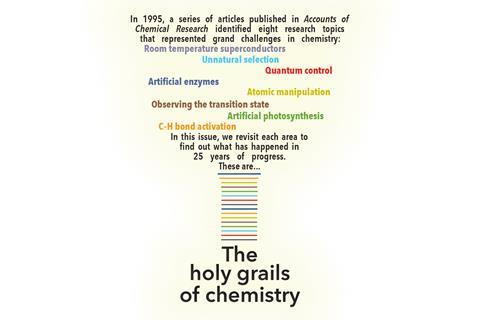
A number of people working in these fields who we interviewed have already won Nobel prizes, such as Frances Arnold who won the 2018 chemistry prize for her work on directed evolution. But it’s quite possible that some of the people working on these ‘holy grails’ could end up with a Nobel prize given some of the ground-breaking science that they’ve been investigating.
9.25am An adorable prediction
This is just wonderful!
Dinnertime conversation at our house included Lawrence’s predictions for the upcoming #ChemNobel. If he has his way, @CarolynBertozzi will be getting a call late tonight! pic.twitter.com/RJN1jmtZSd
— Frank Leibfarth (@Frank_Leibfarth) October 6, 2020
9.18am Eyes on the prize money
The Nobel prize was the biggest prize of its kind when it got going. As you can see now it’s been overtaken by some newcomers, but the Nobels is still the most prestigious science prize out there – its name recognition goes far beyond any other.
9.15am Crystal ball gazing
As always there’s been plenty of discussion of who or what might win the chemistry Nobel prize. The perennial favourite was John Goodenough for lithium-ion batteries and with him having won the prize last year this opens up the field for a new favourite. The new favourite among chemists on Twitter polled by Nature Chemistry’s editor Stuart Cantrill was gene editing tool Crispr. The discovery, however, is currently at the centre of a legal battle over who discovered it, leading some to suggest that it won’t win a Nobel prize while there are still question marks over precedence.
A month tomorrow, the 2020 #chemnobel will be announced, so it's time for the annual #chemtwitter poll! What topic do you think *will* (not should) garner the prize? (Leave comments suggesting what might win if none of the options in the poll…); RTs appreciated!
— Stuart Cantrill (@stuartcantrill) September 6, 2020
Our news story rounds up many of the predictions that have been made for the chemistry prize. This includes the return of Paul Bracher at ChemBark and Clarivate’s citation crunching approach. However, it seems like the chemistry Nobel committee often like to spring a surprise on us (quasicrystals anyone?), which always makes the announcement one of the most interesting of the three science prizes.
9.10am Data crunching
Last year we spent a long time wrestling with over 100 years of data from the Nobel Foundation looking at who and what wins a chemistry Nobel prize. We’ve updated it for 2020 and I’d thoroughly recommend checking it out. If you’ve ever wondered where laureates were born, the institute that can claim the most Nobelists or which Nobel prize winning paper has received the most citations then you’ll want to take a look. There’s also an awesome interactive map of the world showing where every single chemistry Nobel laureate was born and the institute they moved to to do their prize-winning work.
9.05am Diversity in the Nobel prizes
It’s the question that comes up every year – why aren’t there more women winning Nobel prizes, why do most of the prizes go to scientists in Europe and the US? Chemist Marc Zimmer has served as a consultant aiding the Royal Swedish Academy of Sciences on selection of the Nobel Prize in Chemistry in the past. Consequently, he’s well placed to talk about the problems with diversity the science Nobel prizes have. Unsurprisingly, he notes the reason there have been so few women and that winners tend to white men goes way beyond the Nobel selection committees. He notes:
‘Nomination to receive a Nobel Prize in science or medicine is by invitation only, and information about the nomination and selection process cannot be revealed until 50 years have passed. Despite this confidentiality, based on the list of laureates it’s clear that nominations tend to favour scientists working at elite research institutions, famous scientists who are good at self-promotion and those well known to their peers. Predictably, these tend to be older, established white men.’
8.54am Women in science
You don’t have to be exceptionally eagle-eyed to spot in the stats below that few women have won a science Nobel prize but this data visualisation really hammers this home. That relatively few women rise to the very top in science as a whole has been a matter of debate for a long time now, yet things are still only changing slowly. The Nobel committee has responded by looking at measures to address the imbalance.
8.49am Some science Nobel stats
How does the chemistry prize compare with the physics and physiology or medicine prize on a couple of key measures?
Chemistry prizes: 111
Chemistry laureates: 184
Awarded women: 5
Youngest laureate: 35 (Frederic Joliot 1935 prize)
Oldest laureate: 97 (John Goodenough, one of 2019’s winners)
Medicine prizes: 111
Medicine laureates: 222
Awarded women: 12
Youngest laureate: 32 (Frederick G Banting 1923 prize)
Oldest laureate: 87 (Peyton Rous 1966 prize)
Physics prizes: 114
Physics laureates: 216
Awarded women: 4
Youngest laureate: 25 (Lawrence Bragg 1915 prize)
Oldest laureate: 96 (Arthur Ashkin 2018 prize – he sadly died in September)
8.36am Physics trivia
Yesterday, the Nobel Prize in physics was awarded to Roger Penrose, ‘for the discovery that black hole formation is a robust prediction of the general theory of relativity’, and to Reinhard Genzel and Andrea Ghez ‘for the discovery of a supermassive compact object at the centre of our galaxy.’
BREAKING NEWS:
— The Nobel Prize (@NobelPrize) October 6, 2020
The Royal Swedish Academy of Sciences has decided to award the 2020 #NobelPrize in Physics with one half to Roger Penrose and the other half jointly to Reinhard Genzel and Andrea Ghez. pic.twitter.com/MipWwFtMjz
Roger Penrose is also known for discovering Penrose tiles – rhombus-shaped tiles that can be used to tile an infinite plane in a pattern that never repeats. Penrose tiles are linked to the 2011 Nobel prize in chemistry, which was awarded to Dan Shechtman for his discovery of quasicrystals in 1982. (I should add that there’s a lovely story, almost certainly apocryphal, of Roger Penrose having his hallway done with Penrose tiling. One of the people who supposedly laid the tiling was reported to have said the job was a complete pain, the pattern never repeated!)
(The hallway at the London Institute is actually a Penrose tiling pattern.)
Like Penrose tiles, but unlike traditional crystals, the ordered patterns in quasicrystals don’t repeat regularly. It took many years for quasicrystals to be accepted as they break many of the conventional rules of crystallography.
You can read more about Shechtman and quasicrystals in our feature on the prize-winning work
And back to Penrose briefly, here’s a great piece of trivia…
Back in 1997, Penrose was involved in a legal battle with the makers of Kleenex toilet roll. It turns out that the non-repeating pattern of Penrose tiles is good for making quilted bog roll that doesn’t bunch up.
‘When it comes to the population of Great Britain being invited by a multi-national to wipe their bottoms on what appears to be the work of a Knight of the Realm without his permission, then a last stand must be made,’ commented David Bradley, director of Pentaplex – a company called that produced puzzles based on the Penrose patterns.
Proud. Sir Roger's loo rolls are in our collections https://t.co/o5923moZRT
— Roger Highfield (@RogerHighfield) October 6, 2020
8.24am Your predictions?
If you want to let us know who you think is going to win then take part in our poll. If you don’t think any of those fields will win then let us know which you think might.
Today's the day! 🥳 The chemistry #NobelPrize2020 is all set to be announced at around 10:45 BST, but what do you think is going to win this year? Let us know!
— Chemistry World (@ChemistryWorld) October 7, 2020
8.17am Coming up this morning…
The press conference is expected to start at around 10.45am UK time (11.45am CEST), barring any problems contacting the new Nobel laureate(s). You can watch the proceedings unfold at 10.45am over on the Nobel Foundation’s website. We’ll be tweeting from @ChemistryWorld all things Nobel prize related and recommend the #chemnobel hashtag to keep up with what people are saying. If you have any tips or things you’d like to share then the best way to reach us this morning will be on Twitter.
This year the press conferences have been rather more subdued affairs as a result of the pandemic. The Royal Swedish Academy of the Sciences has been observing social distancing rules, spreading out the committee members and expert scientists and far fewer journalists are present. The Nobel award ceremony and banquet – normally in December – have been cancelled too. This is the first time the Nobel Foundation has cancelled the event since 1956, when they wanted to avoid inviting the Soviet ambassador because of the USSR’s crushing of the Hungarian Revolution. Instead the Nobel lectures and award ceremony will be conducted virtually, while it is hoped that the banquet will take place in 2021. Fingers crossed for all our sakes that things are normal enough again to run the banquet then.
8.07am Welcome everyone
Thanks for joining us this morning in the run-up to the chemistry Nobel prize. We’ll be talking all things Nobel prize related as we await the announcement and sharing our thoughts on who might win, does the prize still matter in this day and age, and what happens when you get the call from Stockholm?
A quick recap on how things stand so far. The physiology or medicine Nobel prize went to Harvey Alter from the US National Institutes of Health, Michael Houghton at Canada’s University of Alberta and Charles Rice at the Rockefeller University in the US on Monday for the discovery of the virus that causes hepatitis C – a virus that affects 1% of the world’s population. Yesterday was the turn of physics and Roger Penrose at the University of Oxford received half the prize for his work on black hole formation, and the other half went to Reinhard Genzel at Max Planck Institute for Extraterrestrial Physics and Andrea Ghez at University of California, Los Angeles for discovering a supermassive compact object at the centre of our galaxy. The award for Ghez brings the number of women who have won a physics Nobel prize to four.
Today is the big one (for us anyway), so stick with us while we bring you the latest news, gossip and comment on the prize. We’ve also gathered all our Nobel prize stories into a single handy place for you.




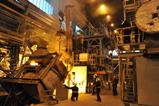
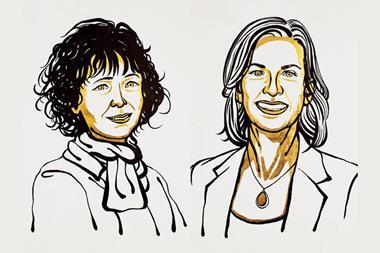
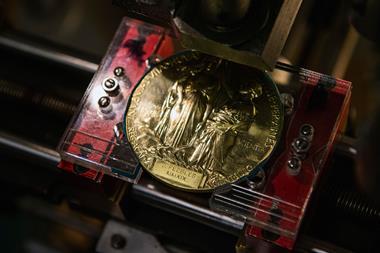
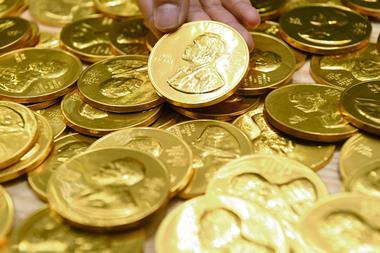









No comments yet